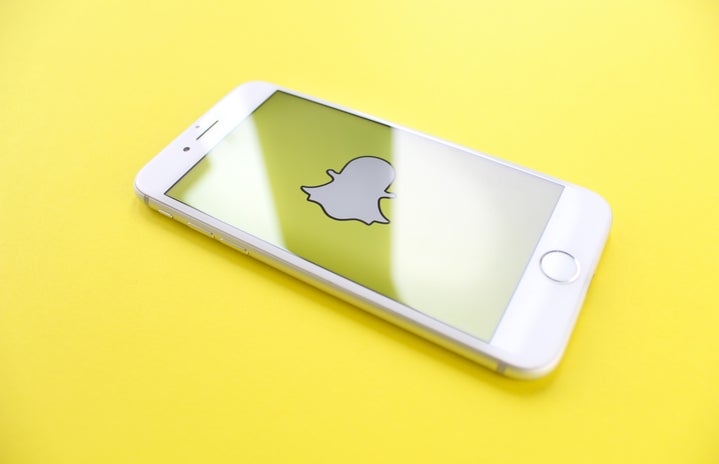*NOTE: This article approaches ‘Snapchat’ relationships from a heterosexual perspective due to the author’s experience in this realm and desire to not make assumptions on queer relationships.*
It’s every hopeless lover’s dream. As beads of sweat drip from your brow and your hair rapidly loses volume, you spot your crush: their hat is on backward, their fist is relentlessly pumping in the air, and ~moan~ a chain is whipping around their neck as they pretend to know the words to the Uzi song blasting in your ears. You happen to brush into them on your way to the hellishly-dirty bathroom. After dancing within their general vicinity for 37 seconds, you hear the magic words: “Hey, you cutie, lemme get your snap.” Cinderella could absolutely never.
This tale as old as time seems to be a universal experience for many college students, but realistically, it begins long before. In theory, it makes sense that many of our first romantic endeavors are conducted over Snapchat. Rather than trying to force full texts to your person of interest throughout the day, keeping in touch is made easy through a back-and-forth volley of shoulder pics and short chats. Your photos and messages alike feel impermanent, more casual. The structure of the app is wildly appealing as an overall medium, but it’s exactly these fun add-ons that make the use of Snapchat that much more complex.
As a thirteen-year-old, there was nothing more exciting than seeing the infamous yellow heart appear next to your current crush’s name or watching as they change your chat settings to “delete your messages after 24 hours”. (My closest encounter with drugs in middle school was most definitely the sensation I felt every time I saw my crush was typing.) From pinning conversations to gaining access to your potential crush’s private story, Snapchat sets up implicit “checkpoints” to be navigated as the talking stage blooms. The simple act of being left on “read” or “delivered” was enough to change our days or, in extreme (but not infrequent) cases, how we thought about ourselves overall. Yet – and my point of all of this is – it’s complicated to place these things definitively in the past tense. That’s because there is no such thing as a hard transition out of the Snapchat method of relationships (even after high school).
Demonstrated by the vignette that opened this article, Snapchat doesn’t go away once you reach college. I can’t begin to tell you the number of quick-adds I’ve engaged in this first semester, but it certainly indicates that I won’t be stopping anytime soon. When catching up with friends from other universities over Fall Break, I mentioned that I’d just received a text from a guy I was talking to and found myself surrounded by confused stares. “You TEXT guys at Penn?” one girl asked. Without thinking anything of it, I replied, “Oh God no, we’re just playing 8-Ball.”
Subconsciously, I acknowledged the standardization of the Snapchat talking phase as regular protocol, with texting being an unused form of communication outside of GamePigeon. Still, everyone today bought into this movement early on, and I don’t see the cycle breaking in the near future. Even with a relatively low Snap Score myself, I will use the app exponentially more when I am interested in someone solely because it’s the accepted thing to do. And, even though my general use and understanding of it has changed drastically since I first downloaded the app at age eleven, I was compelled to reflect on its impact when I realized that my attitude towards relationships on Snap hasn’t adapted at all.
Though a self-proclaimed ~independent woman~, at the beginning of college I found myself once again wrapped up in the emotions of waiting for replies or being left on read even by people with whom I was briefly talking. The empty red arrow had the ability to pull my attention from lectures, dance practices, and even sleep, depending on how long it had been. Had they disliked the picture I sent of myself? Was I not interesting enough? Would they ever speak to me again? Despite the internal panic I sometimes felt, I rarely considered that I often leave people on read or delivered for hours or days at a time if I was busy, my phone died, or whatever else. I would take my crush’s responses (or more so, the lack thereof) so personally at times that I would go to bed upset or wake up with anxiety in the morning due to my own overthinking. It’s a simple truth to say that navigating college relationships through the unchanging lens of snaps, stories, and videos can be absolutely exhausting if we don’t change the way we approach it.
Since that fleeting moment during Fall Break, I have finally come to realize that Snapchat is not the end-all be-all of managing your relationship prospects. Acknowledging the casual nature of the app can be all you need to change your perspective; I can tell you that if you think they are the love of your life and you don’t have their phone number, they likely won’t be any sort of endgame for you – and that’s fine! (This is not to say that solid communication and relationship-building can’t take place via Snap, but if you can’t handle them leaving you on read for an hour, it’s likely time to reevaluate.) Take a step back from the white ghost planted on the yellow square and know that you shouldn’t take it too seriously. And, if they ever ask you for your phone number first, add that to the green-flag pile.


